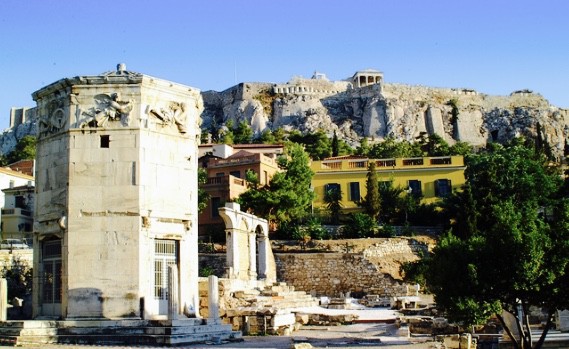It is said to be the world’s first weather station, to date back more than 2,000 years, and to have been used by merchants to tell the time - even in darkness.
The Tower of the Winds, still standing on a slope on Athens’s ancient Acropolis hill despite attempts by Lord Elgin to move it to Britain, has been restored and re-opened to the public for the first time in nearly 200 years.
No one knows who funded its lavish construction - the octagonal monument is made almost entirely of Pentelic marble, the same used for the Parthenon and rarely found in buildings other than temples.
At nearly 14 meters (46 ft) tall, it is credited to the architect and astronomer Andronikos of Cyrrhus, but the greatest mystery remains how the clock worked at night. Based on the most prominent theory, a hydraulic mechanism powered a water clock device with water flowing from a stream on the Acropolis hill.

While you are in Athens, check out the 2,000-year-old marble clocktower known as ‘Aerides’ (Winds) situated in the heart of Athens- north of the Parthenon
‘Tower of the Winds’ is an octagonal Pentelic marble tower in the capital city’s Roman Agora and functioned as a horologion or "timepiece". The structure features a combination of sundials, a water clock, and a wind vane.
A leading monument in Athens, the 12-meter-tall ‘Tower of the Winds’ came to light in the 19th century following excavations by the Archaeological Society of Athens. It’s an octagonal time-telling structure (“horologion”) made of Pentelic marble and designed by Macedonian-born astronomer Andronicus of Cyrrhus in the 1st Century BC.
Lord Elgin and the Dervishes.
The Aerides, bearing this moniker and its primary title throughout its existence, also transformed a church. This transition allowed restoration experts to uncover fragments of frescoes adorned with Christian motifs, such as an angel and a saint on horseback.
Leveraging the capabilities of a multispectral camera, researchers further unveiled the monument's intricate interior and exterior adornments, boasting a spectrum of vibrant hues. Among these, Egyptian Blue adorned the ceiling, while a red and blue meander pattern embellished the borders.
During the twilight years of the city's Ottoman rule, the monument's purpose evolved again, accommodating Sufi Muslim Whirling Dervishes for worship. Notably, a mihrab niche was sculpted to align with the direction of Mecca, and Ottoman inscriptions graced the walls.
Curiously, the monument's transition to a Muslim place of worship was pivotal in its preservation. British diplomat Lord Elgin, infamous for acquiring prized Parthenon Sculptures from the Acropolis two centuries ago, had contemplated relocating the entire monument to Britain in 1799. However, its revered status as a sacred site rendered it immune to such displacement.
Back in 1799, Lord Elgin had envisioned transferring the entire monument to Britain. Nevertheless, its sacred significance rendered it impervious to uprooting.
The most beautiful cities of Ancient Greece
* Image by Maria Theofanopoulou

